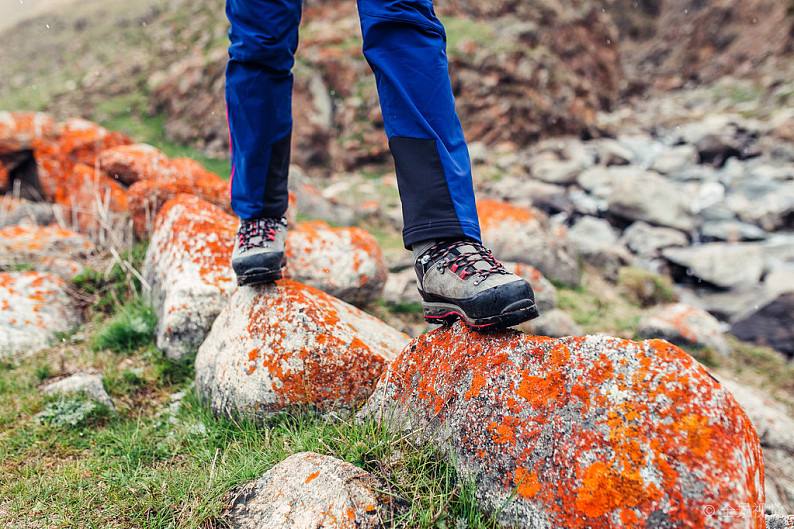Most of us learn how to tie our shoes in elementary school and don’t think much about our laces after that. But if your hiking boots start to feel uncomfortable on your feet, you’ll be happy to discover a few different lacing techniques that can enhance your comfort. How to tie hiking boots perfectly?
Table of Contents
Basic Tie
With a few extra hooks at the top, tying hiking boot laces is very similar to tying shoe laces.
Pull each lace snugly starting at the bottom and working your way up.
Cross the laces once you reach the top hooks, then loop them around the following hook before crossing once more. Tie the laces into a bow once you’re out of hooks.
My laces are always double knotted so I won’t have to tie them again. Some boot laces for hiking shoes lose their knots after a short while.
Laced normally with a double knot
The Goal For Lacing Hiking Boots
At the end of the day, you need your foot to remain pain-free and comfortably in one place. It will hurt if it is tied too tightly.
Blisters can develop as a result of foot movement in boots. You risk getting a blister if your heel slides up and down. Blisters on your toes can result from sliding left and right. Each time you take a step while walking downhill, your feet will slam into the end of the boot as they slide forward and backward.
After lacing, if your heel is still moving, try the Heel Lock in the section below.
Try Window Lacing in the section that follows if you have an area of your foot’s top that is particularly sore.
Describe The Heel Lock Knot
When using the Heel Lock, the lacing will be changed at your ankle, where it begins to go up your leg, after you have finished lacing the boot’s bottom. At this point, D-rings or holes are typically replaced with open hooks on hiking boots. Occasionally, people will refer to them as the speed lacing system. To stop your heel from moving, we’ll adjust the lacing so that we can tighten this area at your ankle. Blisters shouldn’t develop if the heel is immobile.
Along the top of your foot, fasten your boots with the usual laces. As soon as you reach the ankle, where the boot begins to climb your leg, we’ll secure the heel.

Tie the bottom normally
Tie a Surgeon’s Knot at the bottom of your shin
In the hooks, tie a heel lock.
Steps For Tying Hiking Boots
Surgeon’s Knot
Wrap the ends of your laces around each other as you would to tie off, but don’t pull the laces tight
Wrap the laces round each other a second time and THEN pull the ends of the laces tight
Either secure the ends of the laces around the next lace hooks to continue lacing, or tie off with your normal bow
Heel Lock
Make sure to position your boot so that your heel extends as far back as possible.
Find the point on the front of your ankle where your foot meets your leg and identify where this is on your boot
Lace your boots as normal up to this point and then tie a surgeon’s knot (see above)
Run the laces up to the next hook to lock off the knot and tie another surgeon’s knot
Finish lacing as normal up to the top of the boot
Toe Relief
Unlace your boots entirely, that’s right, all of them!
Re-lace your boots as normal but miss out the first eyelets altogether
Window lacing
Identify the main point of pressure and untie your laces to just below this point
Re-lace by going straight up the next hook above this point (instead of straight crossing over)
Now cross the laces and continue lacing up to the top of the boot as normal
Relaxed Ankle
Lace your boots as normal
Run the laces over the top of the top loops
Tie off as normal but below the top loop
Foot Lock Down
Identify the points in your boots that feel especially spacious
Unlace to the lowest point and add a surgeon’s knot at this point and continue lacing
Repeat the surgeon’s knot in any other spots that you feel need to be extra secure
Hiking Boot Laces That Work
Fit and comfort are influenced by both the type of laces you use and how you lace your boots. The length and shape of the laces will vary depending on the type of boot (round or flat). Additionally, they have various stretch qualities. The laces that came with your boots should always be used because they are made specifically for the region of use, the hooks and eyelets, and the boot construction.
When you clean your boots, it’s a good idea to waterproof your bootlaces. Your laces should be washed in warm water if they are really soiled. As sand and debris can seep inside the laces and cause the material to wear out more quickly, this will help them last longer.
Conclusion
It’s quite simple to increase the comfort of your walking boots for long hikes. Additionally, adjusting the lacing if your boots start to feel uncomfortable might save you money by preventing the need to buy a new pair.


